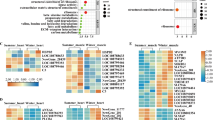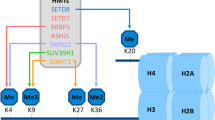Abstract
The North American wood frog, Rana sylvatica, is one of just a few anuran species that tolerates whole body freezing during the winter and has been intensely studied to identify the biochemical adaptations that support freeze tolerance. Among these adaptations is the altered expression of many genes, making freeze-responsive changes to gene regulatory mechanisms a topic of interest. The present study focuses on the potential involvement of microRNAs as one such regulatory mechanism and aims to better understand freeze/thaw stress-induced microRNA responses in the freeze-tolerant wood frog. Using quantitative PCR, relative levels of 53 microRNAs were measured in heart and skeletal muscle of control, 24 h frozen, and 8 h thawed frogs. MicroRNAs showed tissue specific expression patterns: 21 microRNAs decreased in the heart during thawing, whereas 16 microRNAs increased during freezing stress in skeletal muscle. These findings suggest that select genes may be activated and suppressed in heart and skeletal muscle, respectively, in response to freezing. Bioinformatics analysis using the DIANA miRPath program (v.2.0) predicted that the differentially expressed microRNAs may collectively regulate tissue-specific cellular pathways to promote survival of wood frogs undergoing freezing and thawing.


Similar content being viewed by others
Abbreviations
- ARVC:
-
Arrythmogenic right ventricular cardiomyopathy
- cDNA:
-
Complementary DNA
- DIANA:
-
DNA intelligent analysis
- HCM:
-
Hypertrophic cardiomyopathy
- KEGG:
-
Kyoto encyclopedia of genes and genomes
- MAPK:
-
Mitogen-activated protein kinase
- miRNA:
-
MicroRNA
- mRNA:
-
Messenger RNA
- p-bodies:
-
Processing bodies
- qPCR:
-
Quantitative polymerase chain reaction
- pre-miRNA:
-
Precursor microRNA
- pri-miRNA:
-
Primary microRNA
- RISC:
-
RNA-induced silencing complex
- RNA:
-
Ribonucleic acid
- rRNA:
-
Ribosomal RNA
References
Abdellatif M (2012) Differential expression of microRNAs in different disease states. Circ Res 110:638–650. doi:10.1161/CIRCRESAHA.111.247437
Aubert G, Vega RB, Kelly DP (2013) Perturbations in the gene regulatory pathways controlling mitochondrial energy production in the failing heart. Biochim Biophys Acta 1833:840–847. doi:10.1016/j.bbamcr.2012.08.015
Babar IA, Slack FJ, Weidhaas JB (2008) miRNA modulation of the cellular stress response. Future Oncol 4:289–298. doi:10.2217/14796694.4.2.289
Bartel D (2004) MicroRNAs: genomics, biogenesis, mechanism, and function. Cell 116:281–297. doi:10.1016/S0092-8674(04)00045-5
Bassel-Duby R, Olson EN (2006) Signaling pathways in skeletal muscle remodeling. Annu Rev Biochem 75:19–37. doi:10.1146/annurev.biochem.75.103004.142622
Biggar KK, Storey KB (2011) The emerging roles of microRNAs in the molecular responses of metabolic rate depression. J Mol Cell Biol 3:167–175. doi:10.1093/jmcb/mjq045
Biggar KK, Storey KB (2012) Evidence for cell cycle suppression and microRNA regulation of cyclin D1 during anoxia exposure in turtles. Cell Cycle 11:1705–1713. doi:10.4161/cc.19790
Biggar KK, Storey KB (2014) Identification and expression of microRNA in the brain of hibernating bats, Myotis lucifugus. Gene 544:67–74. doi:10.1016/j.gene.2014.04.048
Biggar KK, Dubuc A, Storey K (2009) MicroRNA regulation below zero: differential expression of miRNA-21 and miRNA-16 during freezing in wood frogs. Cryobiology 59:317–321. doi:10.1016/j.cryobiol.2009.08.009
Biggar KK, Wu CW, Storey KB (2014) High-throughput amplification of mature microRNAs in uncharacterized animal models using polyadenylated RNA and stem-loop reverse transcription polymerase chain reaction. Anal Biochem 462:32–34. doi:10.1016/j.ab.2014.05.032
Bugger H, Schwarzer M, Chen D et al (2010) Proteomic remodelling of mitochondrial oxidative pathways in pressure overload-induced heart failure. Cardiovasc Res 85:376–384. doi:10.1093/cvr/cvp344
Chen G-Q, Lian W-J, Wang G-M et al (2012) Altered microRNA expression in skeletal muscle results from high-fat diet-induced insulin resistance in mice. Mol Med Rep 5:1362–1368. doi:10.3892/mmr.2012.824
Cheng Y, Zhu P, Yang J et al (2010) Ischaemic preconditioning-regulated miR-21 protects heart against ischaemia/reperfusion injury via anti-apoptosis through its target PDCD4. Cardiovasc Res 87:431–439. doi:10.1093/cvr/cvq082
Cheng CJ, Bahal R, Babar IA et al (2014) MicroRNA silencing for cancer therapy targeted to the tumour microenvironment. Nature 518:107–110. doi:10.1038/nature13905
Cooley N, Cowley MJ, Lin RCY et al (2012) Influence of atrial fibrillation on microRNA expression profiles in left and right atria from patients with valvular heart disease. Physiol Genom 44:211–219. doi:10.1152/physiolgenomics.00111.2011
Costanzo JP, Lee RE (2005) Cryoprotection by urea in a terrestrially hibernating frog. J Exp Biol 208:4079–4089. doi:10.1242/jeb.01859
Costanzo JP, Reynolds AM, do Amaral MCF et al (2015) Cryoprotectants and extreme freeze tolerance in a subarctic population of the wood frog. PLoS One 10:e0117234. doi:10.1371/journal.pone.0117234
Cowan KJ, Storey KB (2003) Mitogen-activated protein kinases: new signaling pathways functioning in cellular responses to environmental stress. J Exp Biol 206:1107–1115. doi:10.1242/jeb.00220
Elyakim E, Sitbon E, Faerman A et al (2010) hsa-miR-191 is a candidate oncogene target for hepatocellular carcinoma therapy. Cancer Res 70:8077–8087. doi:10.1158/0008-5472.CAN-10-1313
Esteller M (2011) Non-coding RNAs in human disease. Nat Rev Genet 12:861–874. doi:10.1038/nrg3074
Fresno Vara JA, Casado E, de Castro J et al (2004) PI3K/Akt signalling pathway and cancer. Cancer Treat Rev 30:193–204. doi:10.1016/j.ctrv.2003.07.007
Glass DJ (2005) Skeletal muscle hypertrophy and atrophy signaling pathways. Int J Biochem Cell Biol 37:1974–1984. doi:10.1016/j.biocel.2005.04.018
Glass DJ (2010) Signaling pathways perturbing muscle mass. Curr Opin Clin Nutr Metab Care 13:225–229. doi:10.1097/MCO.0b013e32833862df
Greenway SC, Storey KB (2000) Activation of mitogen-activated protein kinases during natural freezing and thawing in the wood frog. Mol Cell Biochem 209:29–37
Guo H, Ingolia NT, Weissman JS, Bartel DP (2010) Mammalian microRNAs predominantly act to decrease target mRNA levels. Nature 466:835–840. doi:10.1038/nature09267
He L, Hannon GJ (2004) MicroRNAs: small RNAs with a big role in gene regulation. Nat Rev Genet 5:522–531. doi:10.1038/nrg1379
Hopkins PM (2006) Skeletal muscle physiology. Contin Educ Anaesth, Crit Care Pain 6:1–6. doi:10.1093/bjaceaccp/mki062
Horowitz A, Menice CB, Laporte R, Morgan KG (1996) Mechanisms of smooth muscle contraction. Physiol Rev 76:967–1003
Huang Y, Li J (2015) MicroRNA208 family in cardiovascular diseases: therapeutic implication and potential biomarker. J Physiol Biochem. doi:10.1007/s13105-015-0409-9
Hunter RB, Stevenson E, Koncarevic A et al (2002) Activation of an alternative NF-κB pathway in skeletal muscle during disuse atrophy. FASEB J 16:529–538
Katz AM, Lorell BH (2000) Regulation of cardiac contraction and relaxation. Circulation 102:IV–69–IV–74. doi:10.1161/01.CIR.102.suppl_4.IV-69
Kornfeld SF, Biggar KK, Storey KB (2012) Differential expression of mature microRNAs involved in muscle maintenance of hibernating little brown bats, Myotis lucifugus: a model of muscle atrophy resistance. Genom Proteom Bioinform 10:295–301. doi:10.1016/j.gpb.2012.09.001
Larson DJ, Middle L, Vu H et al (2014) Wood frog adaptations to overwintering in Alaska: new limits to freezing tolerance. J Exp Biol 217:2193–2200. doi:10.1242/jeb.101931
Layne JR, First MC (1991) Resumption of physiological functions in the wood frog (Rana sylvatica) after freezing. Am J Physiol 261:R134–R137
Liu J, Valencia-Sanchez MA, Hannon GJ, Parker R (2005) MicroRNA-dependent localization of targeted mRNAs to mammalian P-bodies. Nat Cell Biol 7:719–723. doi:10.1038/ncb1274
Liu Y, Hu W, Wang H et al (2010) Genomic analysis of miRNAs in an extreme mammalian hibernator, the Arctic ground squirrel. Physiol Genomics 42A:39–51. doi:10.1152/physiolgenomics.00054.2010
Luu BE, Storey KB (2015) Dehydration triggers differential microRNA expression in Xenopus laevis brain. Gene. doi:10.1016/j.gene.2015.07.027
Luu BE, Tessier SN, Duford DL, Storey KB (2015) The regulation of troponins I, C and ANP by GATA4 and Nk2–5 in heart of hibernating thirteen-lined ground squirrels, Ictidomys tridecemlineatus. PLoS One 10:e0117747. doi:10.1371/journal.pone.0117747
Martof B, Humphries RL (1959) Geographic variation in the wood frog, Rana sylvatica. Am Midl Nat 61:350–389
McAlinden A, Varghese N, Wirthlin L, Chang L-W (2013) Differentially expressed microRNAs in chondrocytes from distinct regions of developing human cartilage. PLoS One 8:e75012. doi:10.1371/journal.pone.0075012
Ogorodnikova N, Arenz C (2015) MicroRNA-145-targeted drug and its preventive effect on pulmonary arterial hypertension (patent WO2012153135 A1). Expert Opin Ther Pat. doi:10.1517/13543776.2015.1025751
Pellissier F, Glogowski CM, Heinemann SF et al (2006) Lab assembly of a low-cost, robust SYBR green buffer system for quantitative real-time polymerase chain reaction. Anal Biochem 350:310–312. doi:10.1016/j.ab.2005.12.002
Robinson BF, Epstein SE, Beiser GD, Braunwald E (1966) Control of heart rate by the autonomic nervous system: studies in man on the interrelation between baroreceptor mechanisms and exercise. Circ Res 19:400–411. doi:10.1161/01.RES.19.2.400
Rodino-Klapac LR (2013) MicroRNA based treatment of cardiomyopathy: not all dystrophies are created equal. J Am Heart Assoc 2:e000384. doi:10.1161/JAHA.113.000384
Romero J, Mejia-Lopez E, Manrique C, Lucariello R (2013) Arrhythmogenic right ventricular cardiomyopathy (ARVC/D): a systematic literature review. Clin Med Insights Cardiol 7:97–114. doi:10.4137/CMC.S10940
Roufayel R, Biggar KK, Storey KB (2011) Regulation of cell cycle components during exposure to anoxia or dehydration stress in the wood frog, Rana sylvatica. J Exp Zool A Ecol Genet Physiol 315:487–494. doi:10.1002/jez.696
Sadoshima J, Izumo S (1993) Mechanical stretch rapidly activates multiple signal transduction pathways in cardiac myocytes: potential involvement of an autocrine/paracrine mechanism. EMBO J 12:1681–1692
Saito K, Kondo E, Matsushita M (2011) MicroRNA 130 family regulates the hypoxia response signal through the P-body protein DDX6. Nucl Acids Res 39:6086–6099. doi:10.1093/nar/gkr194
Schmittgen TD, Livak KJ (2008) Analyzing real-time PCR data by the comparative C(T) method. Nat Protoc 3:1101–1108
Seger R, Krebs E (1995) The MAPK signaling cascade. FASEB J 9:726–735
Storey KB (1987) Organ-specific metabolism during freezing and thawing in a freeze-tolerant frog. Am J Physiol Regul Integr Comp Physiol 253:R292–R297
Storey KB (2004) Strategies for exploration of freeze responsive gene expression: advances in vertebrate freeze tolerance. Cryobiology 48:134–145. doi:10.1016/j.cryobiol.2003.10.008
Storey KB, Storey JM (1984) Biochemical adaption for freezing tolerance in the wood frog, Rana sylvatica. J Comp Physiol B 155:29–36. doi:10.1007/BF00688788
Storey KB, Storey JM (1992) Natural freeze tolerance in ectothermic vertebrates. Ann Rev Physiol 54:619–637
Storey KB, Storey JM (1996) Natural freezing survival in animals. Annu Rev Ecol Syst 27:365–386
Storey KB, Storey JM (2013) Molecular biology of freezing tolerance. Compr Physiol 3:1283–1308. doi:10.1002/cphy.c130007
Sun Y, Chen D, Cao L et al (2013) MiR-490-3p modulates the proliferation of vascular smooth muscle cells induced by ox-LDL through targeting PAPP-A. Cardiovasc Res 100:272–279. doi:10.1093/cvr/cvt172
Taegtmeyer H, Golfman L, Sharma S et al (2004) Linking gene expression to function: metabolic flexibility in the normal and diseased heart. Ann NY Acad Sci 1015:202–213. doi:10.1196/annals.1302.017
Tan S, Li J, Chen X et al (2014) Small molecule inhibitor of myogenic microRNAs leads to a discovery of miR-221/222-myoD-myomiRs regulatory pathway. Chem Biol 21:1265–1270. doi:10.1016/j.chembiol.2014.06.011
Vlachos IS, Kostoulas N, Vergoulis T et al (2012) DIANA miRPath v. 2.0: investigating the combinatorial effect of microRNAs in pathways. Nucl Acids Res 40:W498–W504. doi:10.1093/nar/gks494
Wang C, Wang S, Zhao P et al (2012a) MiR-221 promotes cardiac hypertrophy in vitro through the modulation of p27 expression. J Cell Biochem 113:2040–2046. doi:10.1002/jcb.24075
Wang J, Song Y, Zhang Y et al (2012b) Cardiomyocyte overexpression of miR-27b induces cardiac hypertrophy and dysfunction in mice. Cell Res 22:516–527. doi:10.1038/cr.2011.132
Wu CW, Biggar KK, Storey KB (2013) Dehydration mediated microRNA response in the African clawed frog Xenopus laevis. Gene 529:269–275. doi:10.1016/j.gene.2013.07.064
Wu C-W, Biggar KK, Storey KB (2014) Expression profiling and structural characterization of microRNAs in adipose tissues of hibernating ground squirrels. Genom Proteom Bioinform 12:284–291. doi:10.1016/j.gpb.2014.08.003
Yang W, Shao J, Bai X, Zhang G (2015) Expression of plasma microRNA-1/21/208a/499 in myocardial ischemic reperfusion injury. Cardiology 130:237–241. doi:10.1159/000371792
Zhang J, Storey KB (2012) Cell cycle regulation in the freeze tolerant wood frog, Rana sylvatica. Cell Cycle 11:1727–1742. doi:10.4161/cc.19880
Zhang J, Storey KB (2013) Akt signaling and freezing survival in the wood frog, Rana sylvatica. Biochim Biophys Acta 1830:4828–4837. doi:10.1016/j.bbagen.2013.06.020
Acknowledgments
Thanks to J. M. Storey for editorial review of the manuscript. This work was supported by a Discovery grant (#6793) from the Natural Sciences and Engineering Research Council of Canada (NSERC). KBS holds the Canada Research Chair in Molecular Physiology, and BEL holds an NSERC Canada Graduate Scholarship.
Author information
Authors and Affiliations
Corresponding author
Ethics declarations
Conflict of interest
The authors declare that they have no conflict of interest.
Additional information
Communicated by I. D. Hume.
Appendices
Appendix 1
See Table 3.
Appendix 2
See Table 4.
Appendix 3
Rights and permissions
About this article
Cite this article
Bansal, S., Luu, B.E. & Storey, K.B. MicroRNA regulation in heart and skeletal muscle over the freeze–thaw cycle in the freeze tolerant wood frog. J Comp Physiol B 186, 229–241 (2016). https://doi.org/10.1007/s00360-015-0951-3
Received:
Revised:
Accepted:
Published:
Issue Date:
DOI: https://doi.org/10.1007/s00360-015-0951-3




